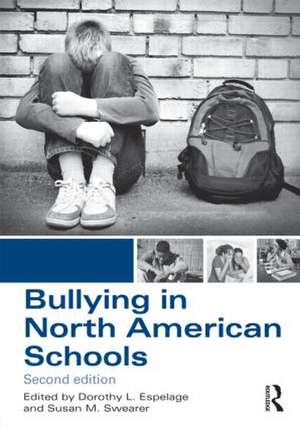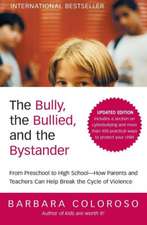Bullying in North American Schools
Editat de Dorothy L. Espelage, Susan M. Sweareren Limba Engleză Paperback – 18 oct 2010
This new edition:
- illustrates the complexity of bullying behaviors and offers suggestions for decision-making to intervene and work to reduce bullying behaviors
- provides empirical guidance for school personnel as they develop bullying prevention and intervention programs or evaluate existing programs
- uses a social-ecological perspective in which bullying is examined across multiple contexts including individual characteristics, peer and family influences, and classroom dynamics
- includes basic research data from leaders in the field of bullying and victimization in the United States and Canada
- teaches practical implications of various types of programs and how to choose and implement one that fits their school ecology.
| Toate formatele și edițiile | Preț | Express |
|---|---|---|
| Paperback (1) | 534.57 lei 6-8 săpt. | |
| Taylor & Francis – 18 oct 2010 | 534.57 lei 6-8 săpt. | |
| Hardback (1) | 1283.92 lei 6-8 săpt. | |
| Taylor & Francis – 18 oct 2010 | 1283.92 lei 6-8 săpt. |
Preț: 534.57 lei
Preț vechi: 628.90 lei
-15% Nou
Puncte Express: 802
Preț estimativ în valută:
102.30€ • 111.09$ • 85.93£
102.30€ • 111.09$ • 85.93£
Carte tipărită la comandă
Livrare economică 22 aprilie-06 mai
Preluare comenzi: 021 569.72.76
Specificații
ISBN-13: 9780415806558
ISBN-10: 0415806550
Pagini: 336
Ilustrații: 18
Dimensiuni: 178 x 254 x 18 mm
Greutate: 0.62 kg
Ediția:Revised.
Editura: Taylor & Francis
Colecția Routledge
Locul publicării:Oxford, United Kingdom
ISBN-10: 0415806550
Pagini: 336
Ilustrații: 18
Dimensiuni: 178 x 254 x 18 mm
Greutate: 0.62 kg
Ediția:Revised.
Editura: Taylor & Francis
Colecția Routledge
Locul publicării:Oxford, United Kingdom
Public țintă
Postgraduate and UndergraduateCuprins
1. Expanding the Social-Ecological Framework of Bullying Among Youth, Espelage, D. L., & Swearer, S.M.
Part I: Individual Characteristics Associated With Bullying
2. Gender and Bullying: Moving Beyond Mean Level Differences to Consider Conceptions of Bullying, Processes by which Bullying Unfolds, and Cyber Bullying, Underwood, M. K., & Rosen, L. H.
3. Why Does Being Bullied Hurt So Much?: Insights from Neuroscience, Vaillancourt, T., Hymel, S., & McDougall, P.
4. Bullying among Students with Disabilities: Impact and Implications, Rose, C. A.
5. Internalizing Problems in Students Involved in Bullying and Victimization: Implications for Intervention, Swearer, S.M., Collins, A., Haye-Radliff, K., & Wang, C.
6. Unwanted sexual and harassing experiences: From School to Text Messaging, Ybarra, M. L., Espelage, D. L., Martin, S.
Part II: Peer Characteristics Associated With Bullying
7. Teaching Practices, Classroom Peer Ecologies, and Bullying Behaviors among Schoolchildren, Rodkin, P.C., & Gest, S.D.
8. Part of the Problem and Part of the Solution: The Role of Peers in Bullying, Dominance, and Victimization During the Transition From Primary School to Secondary School, Pellegrini, A.D., Van Ryzin, M.J.
9. Sidestepping the Jingle Fallacy: Bullying, Aggression, and the Importance of Knowing the Difference, Hawley, P.H., Stump, K.N., & Ratliff, J.
Part III: Classroom Characteristics Associated With Bullying
10. Teachers' Attitudes Toward Bullying, Holt, M.K., Keyes, M., & Koenig, B.
11. Girls, Boys, and Bullying in Preschool: The Role of Gender in the Development of Bullying, Hanish, L.D., Hill, A., Gosney, S., Fabes, R.A., & Martin, C.L.
12. Classroom Ecologies that Support or Discourage Bullying, Doll, B., Song, S., Champion, A., & Jones, K.
Part IV: Beyond the Classroom: Considering School Climate, Family Relationships, Social Support, and Innovative School Partnerships
13. School Climate and Change in Personality Disorder Symptom Trajectories Related to Bullying: A Prospective Study, Kasen, S., Johnson, J.G., Chen, H., Crawford, T.N., & Cohen, P.
14. The Role of Social Support in the Lives of Students Involved in Bullying, Demaray, M.K., & Malecki, C.K.
15. Family Relationships of Bullies and Victims, Duncan, R.C.
16. Considerations when Measuring Outcomes to Assess for the Effectiveness of Bullying- and Aggression-Prevention Programs in the Schools, Leff, S.S., Freedman, M.A., MacEvoy, J.P., & Power, T.P.
Part V: Effective Prevention and Intervention Programs
17. Bully Busters: A Resource for Schools and Parents to Prevent and Respond to Bullying, Horne, A.M., Bell, C.D., Raczynski, K.A., & Whitford, J.L.
18. Integrating Strategies for Bullying, Sexual Harassment, and Dating Violence Prevention: The Expect Respect Elementary School Project 6/24/09, Rosenbluth, B., Whitaker, D.J., Valle, L.A., & Ball, B.
19. Overview of Bully-Proofing your School, Plog, A., Porter, B., et al.
20. Teacher Support of Bullying Prevention: The good, the bad, and the promising, Frey, K.S., Jones, D.C., Hirschstein, M.K., & Edstrom, L.V.
21. Design and Analysis of a Randomized Controlled Trial of Steps to Respect: A School-Based Bullying Prevention Program, Low, S.M., Smith, B.H., Fernandez, K., Hanson, K., & Haggerty, K.P.
22. Implementation of the Olweus Bullying Prevention Program in American Schools: Lessons Learned From the Field, Limber, S. P.
Part I: Individual Characteristics Associated With Bullying
2. Gender and Bullying: Moving Beyond Mean Level Differences to Consider Conceptions of Bullying, Processes by which Bullying Unfolds, and Cyber Bullying, Underwood, M. K., & Rosen, L. H.
3. Why Does Being Bullied Hurt So Much?: Insights from Neuroscience, Vaillancourt, T., Hymel, S., & McDougall, P.
4. Bullying among Students with Disabilities: Impact and Implications, Rose, C. A.
5. Internalizing Problems in Students Involved in Bullying and Victimization: Implications for Intervention, Swearer, S.M., Collins, A., Haye-Radliff, K., & Wang, C.
6. Unwanted sexual and harassing experiences: From School to Text Messaging, Ybarra, M. L., Espelage, D. L., Martin, S.
Part II: Peer Characteristics Associated With Bullying
7. Teaching Practices, Classroom Peer Ecologies, and Bullying Behaviors among Schoolchildren, Rodkin, P.C., & Gest, S.D.
8. Part of the Problem and Part of the Solution: The Role of Peers in Bullying, Dominance, and Victimization During the Transition From Primary School to Secondary School, Pellegrini, A.D., Van Ryzin, M.J.
9. Sidestepping the Jingle Fallacy: Bullying, Aggression, and the Importance of Knowing the Difference, Hawley, P.H., Stump, K.N., & Ratliff, J.
Part III: Classroom Characteristics Associated With Bullying
10. Teachers' Attitudes Toward Bullying, Holt, M.K., Keyes, M., & Koenig, B.
11. Girls, Boys, and Bullying in Preschool: The Role of Gender in the Development of Bullying, Hanish, L.D., Hill, A., Gosney, S., Fabes, R.A., & Martin, C.L.
12. Classroom Ecologies that Support or Discourage Bullying, Doll, B., Song, S., Champion, A., & Jones, K.
Part IV: Beyond the Classroom: Considering School Climate, Family Relationships, Social Support, and Innovative School Partnerships
13. School Climate and Change in Personality Disorder Symptom Trajectories Related to Bullying: A Prospective Study, Kasen, S., Johnson, J.G., Chen, H., Crawford, T.N., & Cohen, P.
14. The Role of Social Support in the Lives of Students Involved in Bullying, Demaray, M.K., & Malecki, C.K.
15. Family Relationships of Bullies and Victims, Duncan, R.C.
16. Considerations when Measuring Outcomes to Assess for the Effectiveness of Bullying- and Aggression-Prevention Programs in the Schools, Leff, S.S., Freedman, M.A., MacEvoy, J.P., & Power, T.P.
Part V: Effective Prevention and Intervention Programs
17. Bully Busters: A Resource for Schools and Parents to Prevent and Respond to Bullying, Horne, A.M., Bell, C.D., Raczynski, K.A., & Whitford, J.L.
18. Integrating Strategies for Bullying, Sexual Harassment, and Dating Violence Prevention: The Expect Respect Elementary School Project 6/24/09, Rosenbluth, B., Whitaker, D.J., Valle, L.A., & Ball, B.
19. Overview of Bully-Proofing your School, Plog, A., Porter, B., et al.
20. Teacher Support of Bullying Prevention: The good, the bad, and the promising, Frey, K.S., Jones, D.C., Hirschstein, M.K., & Edstrom, L.V.
21. Design and Analysis of a Randomized Controlled Trial of Steps to Respect: A School-Based Bullying Prevention Program, Low, S.M., Smith, B.H., Fernandez, K., Hanson, K., & Haggerty, K.P.
22. Implementation of the Olweus Bullying Prevention Program in American Schools: Lessons Learned From the Field, Limber, S. P.
Notă biografică
Dorothy L. Espelage is Professor in the Child Development Division of the Educational Psychology department at the University of Illinois at Urbana-Champaign.
Susan M. Swearer is Associate Professor of School Psychology in the Department of Educational Psychology at the University of Nebraska-Lincoln.
Susan M. Swearer is Associate Professor of School Psychology in the Department of Educational Psychology at the University of Nebraska-Lincoln.
Descriere
This book provides an exciting compilation of research, with a social-ecological perspective that illustrates the complexity of bullying behaviors and offers suggestions for data-based decision-making to intervene and reduce those behaviors.










